
Soil Erosion Causes, Types, Ways To Reduce And Prevent
Erosion degrades soil quality and is a major reason for farmland loss in the world. Understanding soil erosion causes and its mechanisms will slow down field destruction. Its effects can be quite severe, but prevention and reduction measures, as well as early problem detection, will mitigate the risks. Satellite technologies for remote crop control can help here because soil erosion correlates with vegetation level in a field.
What Is Soil Erosion And How Is It Working?
Erosion of soil is a deterioration of land due to the removal of its particles. It consists of three basic stages: dislodgement, transportation, and sedimentation. Their speed depends on the soil type, aggregation, infiltration, and ground cover. For example, well-aggregated fields are less vulnerable, and bare lands are the easiest to be destroyed. Slopes require additional protection from water erosion during rain showers, which can be addressed with cover crops, perennial grasses, or terrace farming.
Causes Of Soil Erosion: Why Does It Happen?
There are natural and anthropogenic factors. Topsoil in fields is taken away by winds or quick water run-offs during heavy rainfalls. However, there is also the erosion of soil caused by farming itself when it is managed poorly.
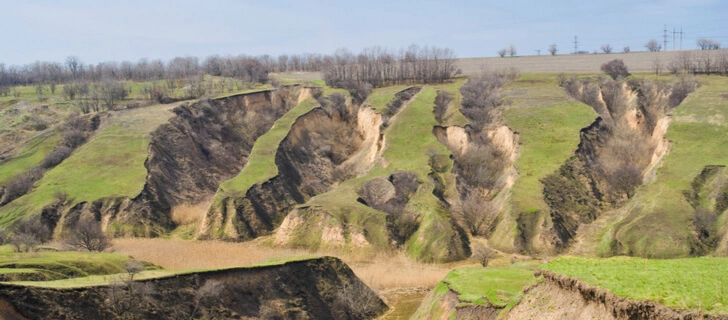
Natural Factors Of Soil Erosion
- Strong wind gusts. Heavy winds remove dry tiny earth particles, which is a typical problem in semi-arid regions leading to desertification.
- Climate change. Abnormal rainfalls or temperature leaps destroy the field surface. Another effect of climate change on soil erosion is stunted vegetation growth that reduces field cover and exposes it to rains and winds.
- Rainfall and Flooding. Excessive rains wash away topsoil particles, while large raindrops hit the field surface and destroy it with heavy splashes. Running currents during floods is another cause of soil erosion.
- Wildfires. Trees and shrubs slow down water run-offs. When forests or buffer zones are destroyed by wildfires, water streams have no obstacles in their way.
Soil Erosion By Human Activities
Apart from natural factors, soil erosion occurs due to irresponsible farm management or deforestation for urban area expansion, tourism development, road construction, and more.
Farming Practices That Cause Soil Erosion
Natural vegetation is by far better protection than crops because farmlands are more vulnerable to rainfall and winds. Besides, agricultural practices can cause soil erosion due to a reduction of biodiversity both in vegetation variety and soil microorganisms. In its turn, a lack of organic matter and beneficial biota negatively impacts field fertility because not only earth particles but nutrients are taken away from bare fields.
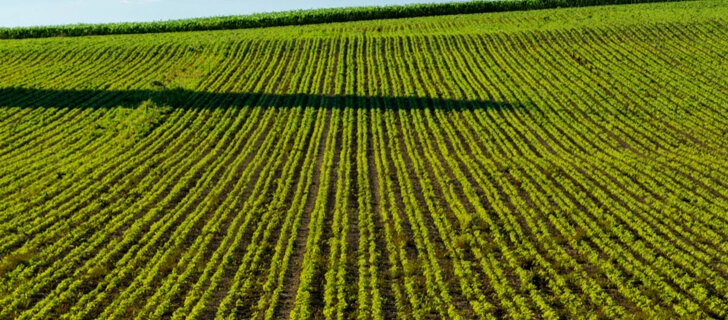
The primary causes of soil erosion due to poor farm management are excessive fertilization or irrigation, conventional tillage, monocropping, overgrazing, and more. Let’s consider the impact of the separate farming practices on erosive processes.
Does monocropping cause soil erosion? Monocropping, or monoculture, implies growing the same crop for several seasons. Since each crop requires particular nutrients, this practice causes field depletion. Consequently, it may result in land degradation and soil erosion.
Can conventional tillage cause erosion in fields? It can. In particular, moldboard plowing makes the earth loose contributing to agricultural soil erosion by water and winds. Conversely, no-till farming prevents these processes.
Do fertilizers cause soil erosion? It may happen. Excessive use of mineral fertilizers under insufficient organic fertilization leads to dehumidification and destruction of its structure, which in turn makes it more vulnerable to erosive processes.
Does irrigation cause soil erosion? Sometimes it can. Artificial irrigation is the only way to produce crops under a lacking natural water supply but excessive irrigation can cause topsoil erosion. It particularly refers to surface irrigation when nutrients and topsoil particles are removed from uneven fields due to gravity.
Does overgrazing cause soil erosion? It does. Livestock overgrazing is a vivid example of poor pasture management that destroys topsoil cover promoting erosive processes. Rotational grazing and cover crops can solve the problem.
Does terrace farming cause soil erosion? It doesn’t. On the contrary, terrace farming prevents erosion by slowing down water streams on even platforms.
Erosion Of Soil Caused By Logging And Deforestation
Any tree felling can speed up erosive processes, be it timber harvesting or expansion of agricultural lands for oil palm cultivation. The clear-cutting practice, when all or most of the trees are removed, exposes the forestlands most.
- cast a shadow to protect its surface from drying out;
- fix the forestland with roots;
- slow down water run-offs;
- enrich the forest floor with organic matter.
Types Of Soil Erosion
The classification is based on the speed of the erosive process or its cause (agent). Thus, different types of soil erosion fall into accelerated or gradual, anthropogenic or natural. The main agents of soil erosion due to natural factors are water currents and wind storms, yet the situation may be aggravated by human activities as well.
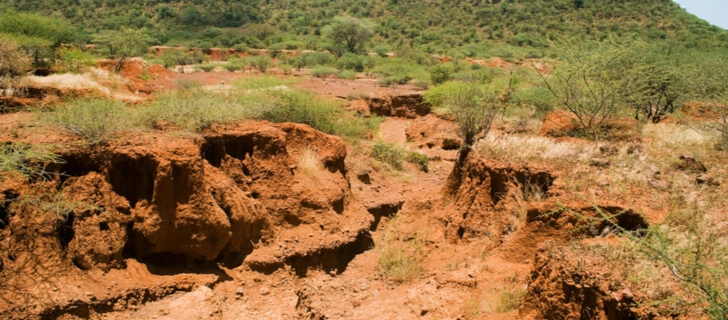
Water Erosion
As the name suggests, this soil erosion type is caused by water and implies topsoil removal after rainfall, snowmelt, floods, or poorly managed irrigation. Thus, it can occur both due to weather extremities or farming activities. In bare terrains and under intense rainfall or melting, destruction by water happens faster.
The main types of soil erosion by water are bank, sheet, rill, gully, and splash ones. See their detailed description in our “Water Erosion: Types, Causes, Effects, And Prevention” article.
Wind Erosion
Another erosion-inducing factor is dust storms destroying the topsoil. Dust storms have been a frequent phenomenon in the last decades, especially in arid places. Erodibility increases if the earth is even, fine, and dry. Conversely, ridges reduce wind energy, and rough heavy particles are more difficult to be removed.
Anthropogenic Soil Erosion
This type occurs due to anthropogenic factors, and human activities can induce soil erosion directly and indirectly. For example, a direct impact comes from mining and quarrying. Indirect consequences follow unsustainable management, disturbing the topsoil and increasing erodibility of fields and forest stands.
Effects Of Soil Erosion
Erosive processes impact farming productivity, worsening living standards and well-being of rural communities (both individual farmers and agricultural co-ops). Over time, eroded farmlands lose soil fertility, degrade, and become unsuitable for agricultural activities.
Besides, erosive processes dramatically damage nature, reducing biodiversity and causing ecosystem imbalance. However, this is not the only reason why soil erosion is a problem. It often remains unnoticed, and the land decay becomes irreparable.
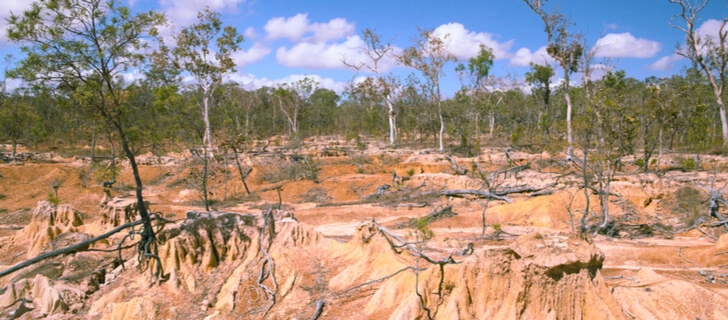
Effects Of Soil Erosion On Agriculture
Erosion progresses differently in individual fields, and the time it takes is also different. Erosive processes on farms may run slowly but can be speeded up by weather or field treatment events. In particular, field salinization or compaction due to heavy machinery movement or overgrazing worsens water infiltration and promotes erosion.
Over time, eroded farmlands degrade and become unsuitable for agricultural activities. It happens due to such negative effects of soil erosion as depletion of topsoil, planting material, water pollution, field acidification, etc.
Losses Of Topsoil
Topsoil is the richest earth’s layer with organic matter and nutrients, so its removal by water or wind essentially worsens field fertility, which is a critical effect of soil erosion on agricultural land. Besides, rills or gullies significantly complicate the cultivation of eroded lands.
Soil Acidification
A lack of organic matter may increase field acidity, which slows down crop development and exposes farmlands to water and wind.
Losses In Planting Material
Water streams or dust storms take away seeds from the fields and destroy seedlings, which results in crop losses and decreases farmers’ profits.
Water Pollution
Other consequences of soil erosion are sedimentation and contamination of water bodies with chemical substances from the fields, which, in turn, spoils the quality of irrigation water.
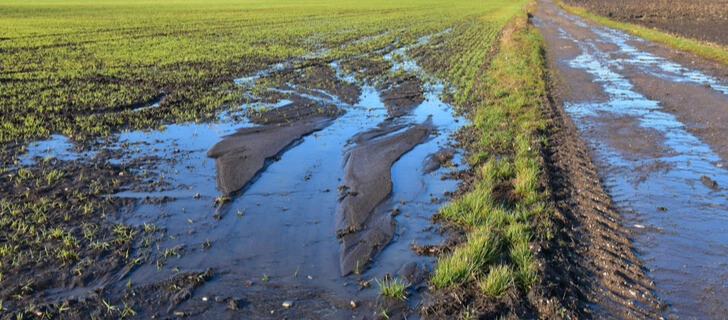
Environmental Impact Of Soil Erosion
Negative consequences for agriculture are not the only nuisance. Examples of damage caused by soil erosion are decay in aquatic inhabitants and plants, biodiversity loss, sedimentation, and frequent flooding.
Frequent Flooding Events
When forests are converted into pastures or fields, there is always a risk of frequent flooding because the trees’ roots fix the land. Such areas also lose their infiltration properties, which also contributes to flooding and waterlogging.
Clogged Waterways And Polluted Aquatics
Long-term effects of soil erosion include waterway clogging and siltation. Besides, eroded particles not only produce sedimentation in evener areas but clog grassed waterways, dams, and water pumps. Quite often, water currents from fields contain chemicals that are dangerous for people and animals and poison drinking water.
Loss Of Biodiversity
Eroded lands have sparse vegetation and become completely bare over time. It means not only decay in local flora but fauna as well because many organisms are deprived of their natural habitats. The loss of biodiversity results in ecosystem imbalance.
Reduced Greenhouse Gases Sequestration
Vegetation and trees are great carbon dioxide storage, but eroded lands can hardly support their growth. Besides, soils also can also act as CO2 sinks themselves . According to Professor Peter Smith from Aberdeen University, the earth can keep nearly 5% of anthropogenic greenhouse gases per year. Sustainable management could improve the situation and stop the loss of carbon-sequestering vegetation on our planet, reducing greenhouse gases released by deforestation.
Solutions To Soil Erosion
Decision-making in soil erosion control depends on factors like the soil type, topography, or climate specifics, and applied agricultural practices like tillage system or crop rotation. It is important to analyze the effectiveness of undertaken methods and adjust them for individual fields.
Success starts with early problem detection and the choice of suitable methods depending on its severity. For example, replanting, cover crops, or mulching can be good ways to reduce soil erosion in the initial stages because vegetation protects fields from destruction by water run-offs, raindrops, and wind. In severe cases, the impact can be mitigated with terrace farming or check dams.
Other soil erosion control measures include contour cropping and planting perennials with strong root systems to fix the ground and slow down water streams.
EOSDA Crop Monitoring
Offering high-resolution satellite images for fields analytics to monitor crops health remotely!
How To Prevent Soil Erosion
It’s not that easy to reduce erosive processes and even more difficult to stop them, this is why prevention is by far the best method of control.
Produce Crops On Suitable Lands
Some terrains are extremely prone to erosive processes, so they can’t be used for farming without certain preventive measures to mitigate the risks. Besides, each field type requires specific management to protect soil from erosion.
Practice Terracing And Contour Farming
Because erosion develops fast due to quick run-offs, terrace farming is the only way to grow crops on steep hills. Contour farming decreases soil erosion because plants absorb water and ridges stop it from flowing, which mitigates the destruction risks. Plants with strong roots also fix the land and prevent it from sliding down the slope.
Don’t Leave The Soil Bare
Field cover helps not only reduce but prevent field destruction. Over 30% ground cover for erosion control helps essentially mitigate the risks. Complete cover can be practiced in most grazing and crop production systems.
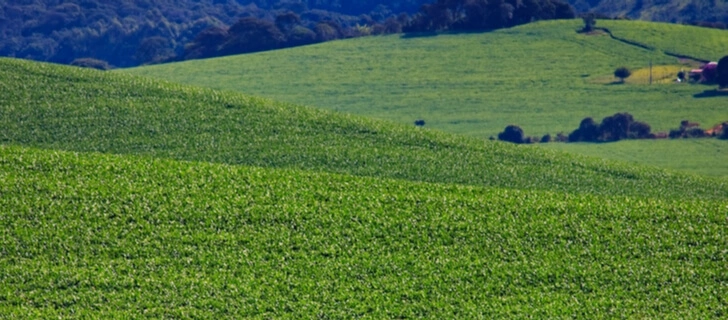
Plant Vegetation
Planting crops help prevent soil erosion by ensuring continuous ground cover, while leaving the field bare promotes erosive processes. Provide soil cover in between the growing season with crop rotation and cover crop practices. Besides, crop rotation reduces soil erosion by fixing the land with alternatively planted deep-rooted crops. Additionally, sequences of high vegetation protect fields from the wind.
Use Mulching
Mulches like straw, dried weeds, or agro textiles don’t only protect the field from rains and wind but retain soil moisture, which protects the earth from cracking. Besides, decomposed mulches of biological origin add nutrients and organic matter to the field, boosting fertility and improving its structure.
Switch To No-Till Or Minimum Tillage
Plowing is a common practice in conventional farming, yet studies prove that the reduction of farmland disturbance in the no-till approach can help reduce soil erosion, too. When soil aggregates and ground cover remain nearly untouched, erosive processes develop slowly.
Add Organic Matter
Healthy topsoil must contain organic matter from decomposed animal manure and plant manure. Organic matter prevents soil erosion in several ways:
- supplies vital nutrients to crops making the ground cover more vigorous;
- improves water retention properties and decreases run-offs;
- binds the earth particles to help it resist currents and winds.
Use Rotational Grazing
When livestock grazes in the same place for a long time, it eats up nearly all vegetation. In turn, ground cover loss often provokes erosion. This is why it is important to let the grazed areas regenerate by moving the cattle to other pastures.
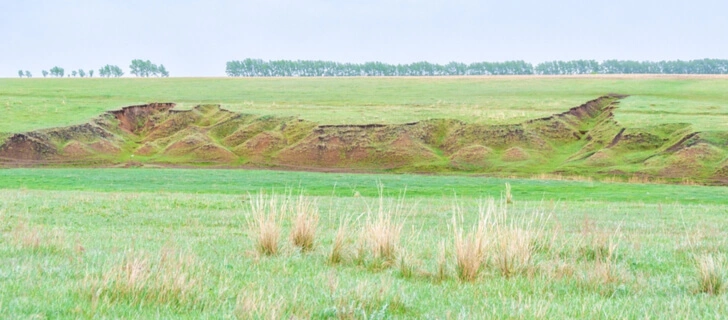
Switch To Drip Irrigation
Because dripping excludes excessive water flows and splashes, it is the best irrigation method used to prevent soil erosion. Dripping systems supply tiny water drops to plant roots at the surface or underground without any destruction risks.
EOSDA Crop Monitoring To Facilitate Prevention And Identification Of Soil Erosion Processes
There are different ways to reduce soil erosion, depending on its type and field specifics. It is typically recommended to use conservation agriculture techniques and sustainable farming practices. By applying modern technologies, growers can enhance the effect of anti-erosion tillage. In terms of soil erosion, remote sensing tools are excellent for monitoring large agricultural areas and can be used by both “big players” of the agricultural sector and small-scale farmers. EOSDA Crop Monitoring is an example of the application of GIS in soil erosion control.
Variable-Rate Fertilizer Application
As defined above, the improper use of certain agrochemicals can provoke wind or water erosion. Soil erosion on cropland often occurs due to excessive mineral fertilization in the absence of an adequate amount of organic fertilizers. Such an approach leads to field dehumification and destruction of its structure. Fields with low humus content are more susceptible to soil erosion, as small non-aggregated soil particles are more easily washed away by water or displaced by the wind. Nonetheless, these negative consequences can be avoided with a rational distribution of mineral and organic fertilizers, facilitated by Variable Rate Application technology.
The variable rate technology on EOSDA Crop Monitoring helps understand the required amounts of mineral and organic fertilizers for different areas depending on their individual needs. By using this feature, farmers can divide their fields into several zones based on vegetation indices maps. Each zone on the map shows certain vegetation intensity, assisting in fertilizer distribution for each zone.
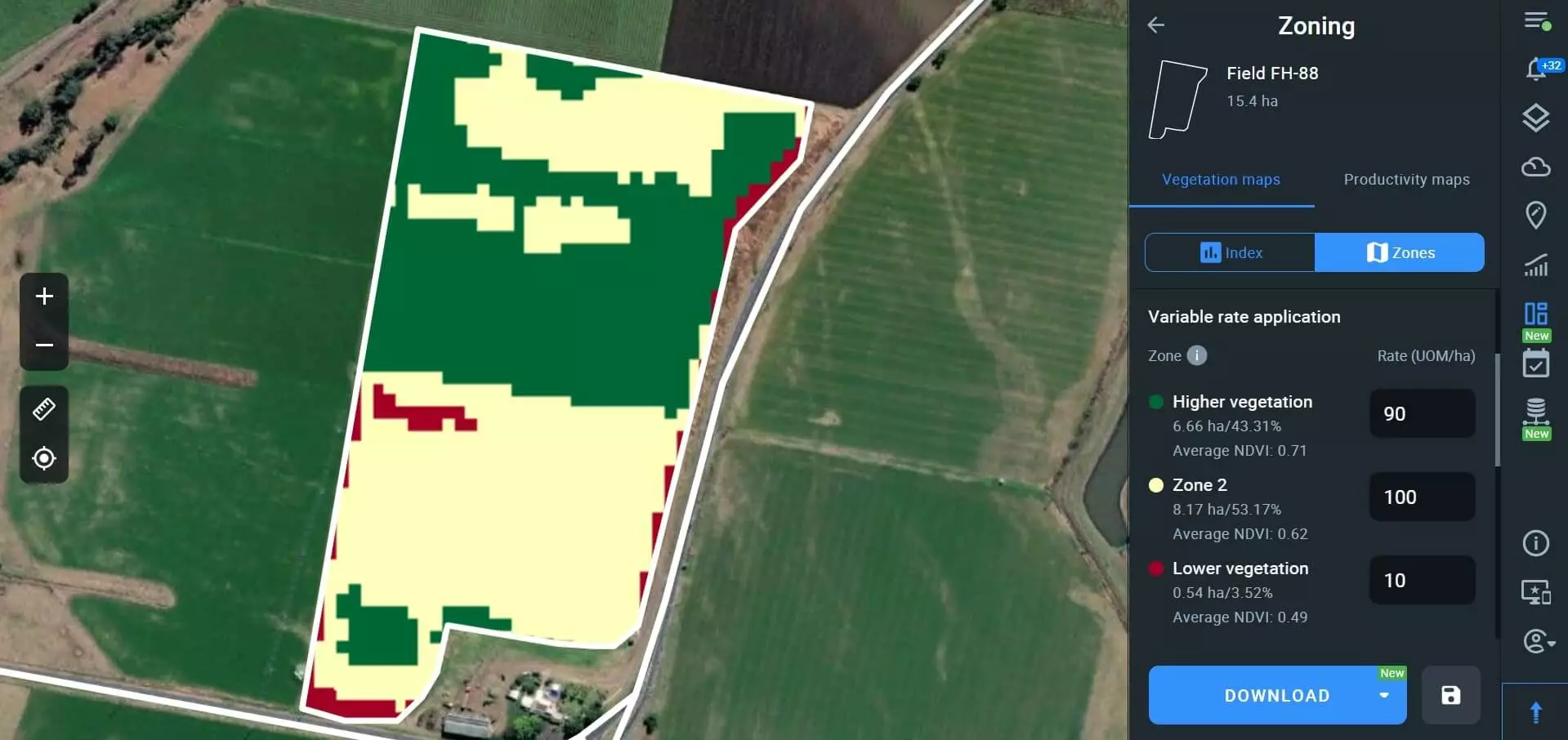
Excessive use of mineral fertilizers results in nutrients leaching from the soil profile, chemical pollution, crop intoxication, and a field productivity decrease. On the other hand, rational application will not only save growers’ costs by reducing the amounts of necessary resources but positively affect the environment, also assisting in the control of soil erosion.
Crop Rotation Planning And Monitoring
Crop rotation is among the key farming practices to reduce soil degradation, including slope erosion. Depending on the slope steepness and already existing erosion manifestations, one or another type of crop rotation is applied, including the vegetative control of soil erosion with perennial grasses. Also, crop rotation is considered an important factor in maintaining high field productivity, since constant cultivation of the same monoculture depletes the field, leading to soil sickness and toxicity.
EOSDA Crop Monitoring functionalities allow for convenient crop rotation tracking in separate fields. The platform users also can add a crop rotation history for each new field for easy tracking and planning of further actions. To do so, just specify the sowing and harvesting dates and the crop name. The added data for each field simplifies the crop sequence planning for the next growing seasons depending on field productivity and needs. Basic crop rotation rules, along with other recommendations, help prevent a decrease in field productivity and the development of soil erosion processes.
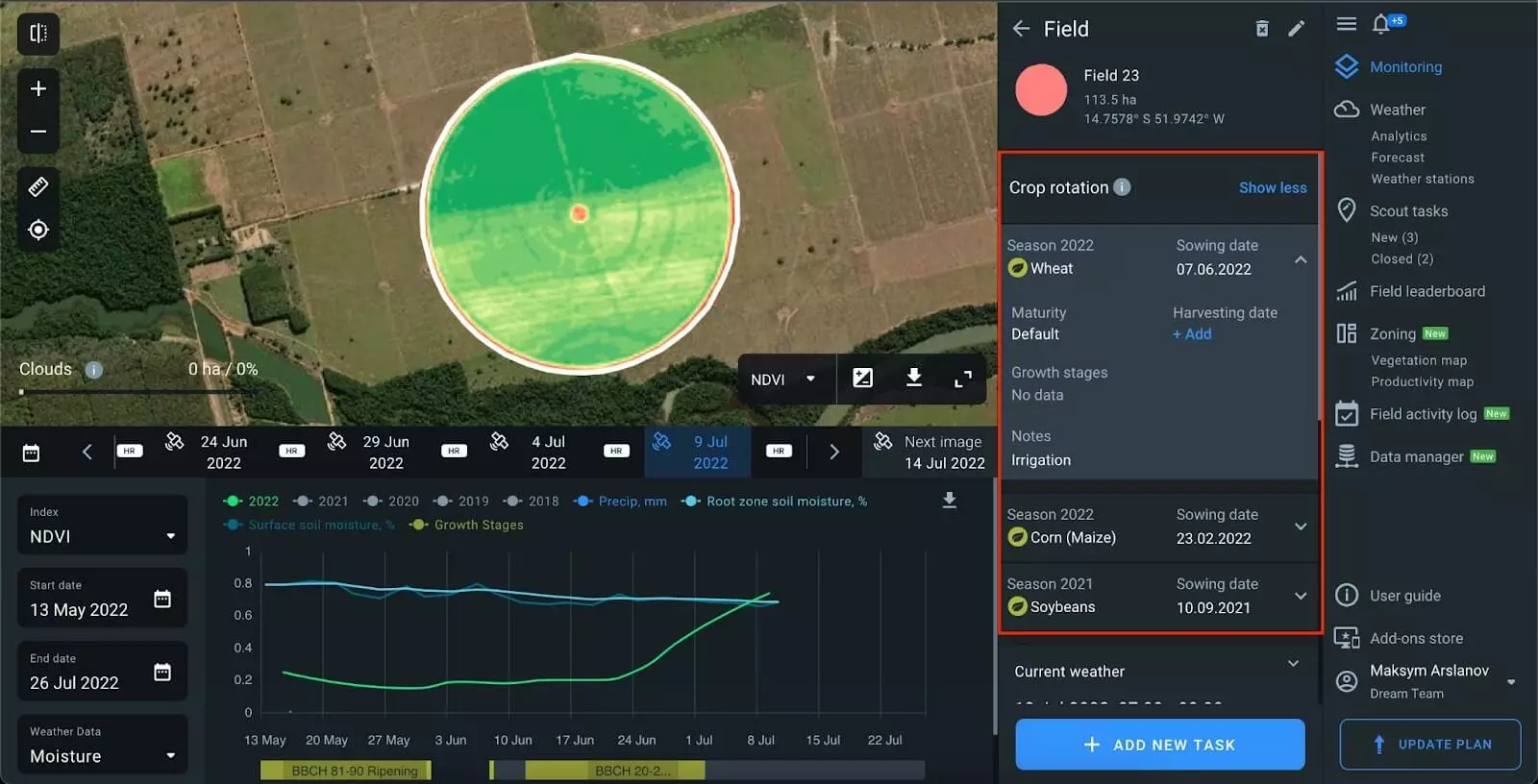
Field Productivity Monitoring
EOSDA Crop Monitoring highlights the current field state with various vegetation indices. Regular satellite imagery updates provide actual information on the crops. Also, the platform users can access historical data on vegetation state changes. With historical data for several years, you can create productivity maps that are generated with cloudless imagery analytics for the selected period.
When comparing productivity maps for different periods, growers can also trace changes in the level of vegetation in the entire field or in its individual zones. Soil erosion mechanisms are one of the reasons for a vegetation level decrease. Once a change is detected, it will make sense to additionally inspect the field and perform soil testing, to understand the cause of vegetation decay, and confirm or exclude the effects of soil erosion on crop productivity.

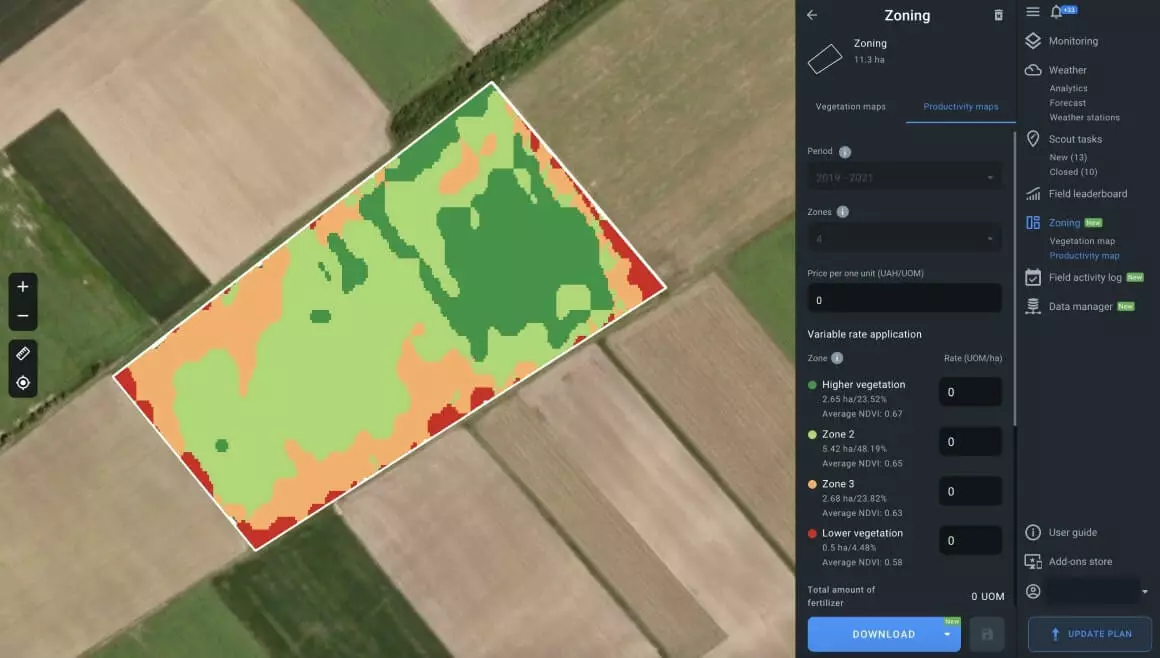
Importance Of Soil Erosion Control
Eroded fields decrease productivity in the whole agricultural sector in the U.S. and across the world, and it is important to notice areas with soil erosion timely until the damage is severe. Most crop producers have managed to slow down the land-destructive processes on their farms, yet the problem still remains a key reason for farmland loss on our planet. This is why growers must know what causes soil erosion and how to stop it early, and EOSDA Crop Monitoring can assist in this challenging task. Contact our sales team for details at sales@eosda.com and get the best out of our platform’s features.
About the author:
Vasyl Cherlinka is a Doctor of Biosciences specializing in pedology (soil science), with 30 years of experience in the field. He attended the engineering college in Ukraine and received his degree in agrochemistry, agronomy and soil science in the Chernivtsi National University. Since 2018, Dr. Cherlinka has been advising EOSDA on problems in soil science, agronomy, and agrochemistry.
Recent articles

Analyze 2025 & Plan Your Best Year Yet: LandViewer Christmas Offer
It’s the most wonderful time of the year! The Christmas holidays are here, and so is your chance to analyze 2025 and plan a prosperous 2026 with more affordable Pro plans in LandViewer.

EOSDA Models Climate Change Impact On Sugarcane Yields
EOSDA modeled future temperature, rainfall, and other climate impacts on Veracruz sugarcane. The results help growers plan long-term adaptation strategies, including timing, varieties, and irrigation.

EOSDA LandViewer Black Friday Sale: Exclusive Offers & Giveaway
This Black Friday, LandViewer offers new users the chance to save on monthly plans, get extra months with yearly subscriptions, and participate in a free annual plan giveaway.